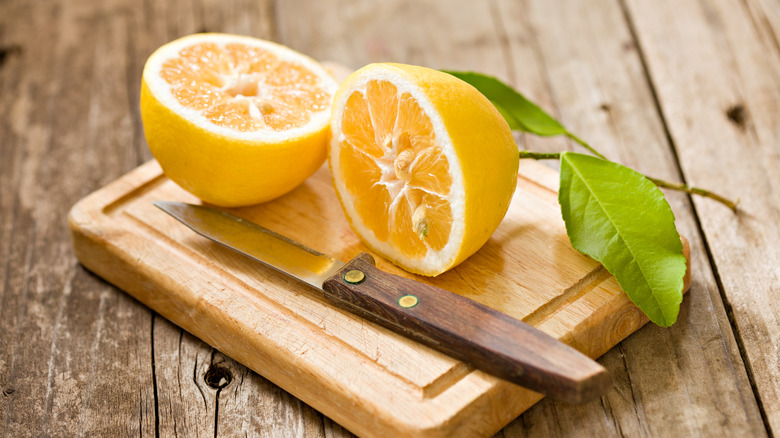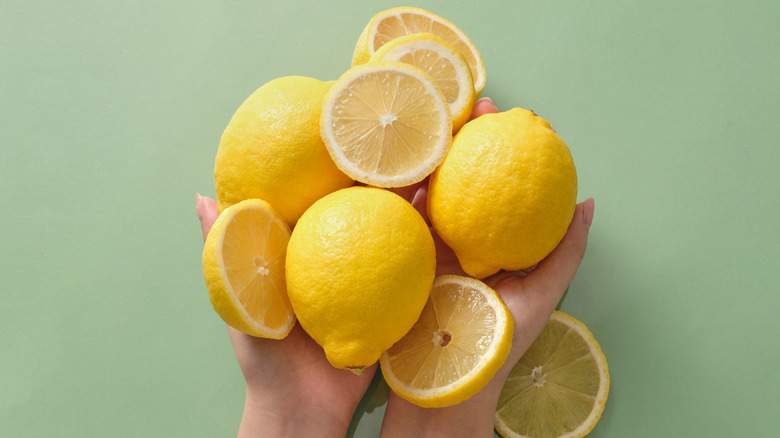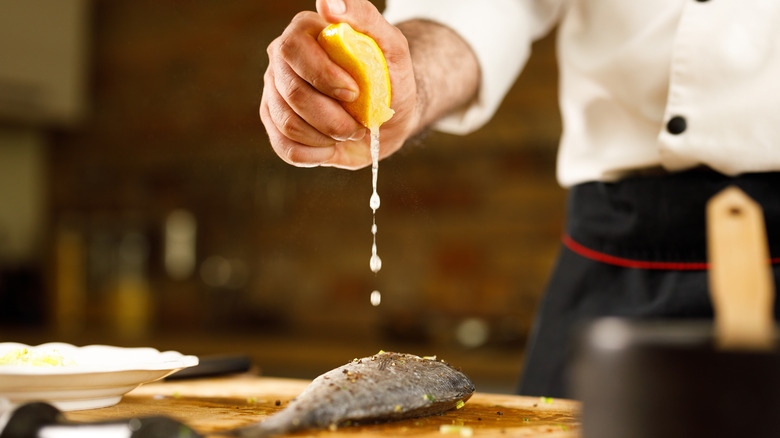What's The Difference Between Meyer Lemons And Regular Lemons?
Some produce is special. For example, the always-stunning dragon fruit or perfect, in-season peaches and berries that arrive for a short while and quickly disappear until next year. Other fruit seems more ho-hum and easy to take for granted. Take lemons: We see them whenever we go to the store. These citrus fruits may be versatile in making many dishes — sweet and savory alike — but aren't necessarily exciting. Meyer lemons are an exception. When they show up between late fall and early winter, people swoon. But what makes a Meyer lemon so exciting?
The most apparent difference is the taste. Conventional lemons, generally Eureka or Lisbon varieties, are tart enough to make your mouth pucker up. Meyer lemons, native to China, taste recognizably lemony and bring a dose of acidity — but significantly less than conventional lemons. While sweet enough to be added raw to various dishes, you probably wouldn't want to eat one whole like an orange. However, you can mix chunks or slices of Meyer lemon into salads and salsas.
The zest of regular lemons and Meyer lemons is fragrant and bright, but Meyer lemon zest has a more floral, subtly spicy depth. Meyer lemon peels are thinner, too, with less bitter white pith beneath, meaning you can eat the entire fruit (sans seeds) in some preparations. However, to do this, ensure your fruit is organic and untreated with wax or other coatings — and give it a good scrub.
Other differences between Meyer and conventional lemons
Before lemons became a culinary crop, they were grown for their visual appeal and used as decoration. It makes sense when you behold a beautiful tree with bright citrus fruit; they weren't used for cooking until the 15th century. When you gaze at the fruit, you can see that Meyer lemons are smaller, often rounder, and smoother-skinned than their more common oblong and frequently bumpy cousins. Meyer lemons are a deeper, more orange-toned color than sunny yellow Eureka and Lisbon lemons (both inside and out). Modern Meyer lemons have been genetically crossed with another citrus fruit — mandarin oranges. This contributes to its orange hue.
The other thing that makes Meyer lemons so attractive is that they're comparatively elusive. Meyer lemon season usually begins in late November or early December and ends by March. Their limited window of availability, coupled with their more fragile nature — which makes shipping them more difficult — naturally makes them more expensive than hardier, year-round regular lemons.
How to use (or substitute) Meyer lemons
So, what can you do if you want to make a Meyer lemon recipe and you don't have any on hand? Substitute a mix of equal parts of regular fresh lemon juice and orange or tangerine juice; the latter is a bit more complex and floral. Mandarin juice might be your best option, as Meyer lemons are a hybrid of lemons and mandarin oranges. Similarly, you can use equal parts regular lemon zest and orange, tangerine, or mandarin zest to stand in for grated Meyer lemon peel. You've got options.
You can also make a Meyer lemon recipe with conventional lemon juice or zest instead; the results will be much tangier and far less sweet, so you may need to adjust other ingredients, like sugar or any other sweetener your recipe uses. Conversely, when Meyer lemons are in season, and you want to add them to everything, choose your applications wisely.
If the goal is to brighten a dish with a shot of acid, Meyer lemons won't have as big of an impact and may be wasted — but they'll still lend their unique characteristics to simple vinaigrettes and cocktails. You can try making Meyer lemonade, though it'll be a pricey pitcher. Ultimately, as with anything you make, you can (and should) always taste and adjust the flavor until it's precisely to your liking.


